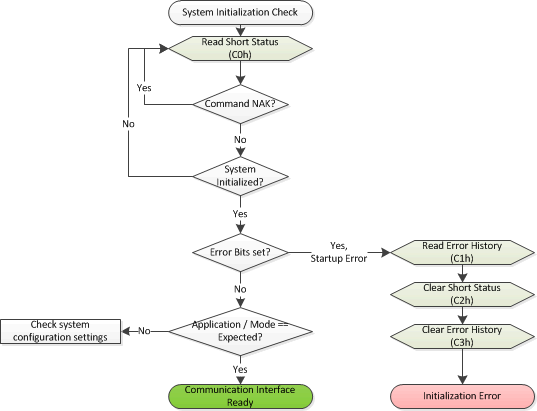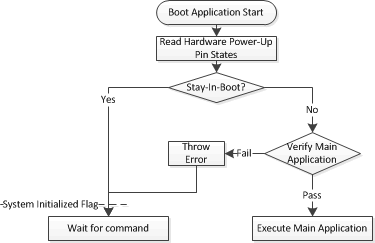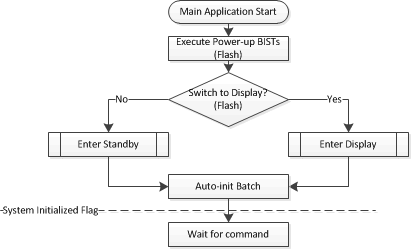DLPU041G April 2016 – July 2024 DLPC230-Q1 , DLPC230S-Q1
- 1
- Trademarks
- 1 Introduction
- 2 Electrical Interface
- 3 Communication Protocol
- 4 System Operation
- 5 Application and Use-Cases
-
6 Tests and Diagnostics
- 6.1 Overview
- 6.2 Emergency Shutdown
- 6.3 Diagnostic Memory Interface
- 6.4
Test Descriptions
- 6.4.1
Periodic Tests
- 6.4.1.1 Video Source Loss Detection
- 6.4.1.2 Video Tell-Tale Checksum
- 6.4.1.3 Video Frame Counter Checksum
- 6.4.1.4 Average Picture Level
- 6.4.1.5 Loss of Dimming Command
- 6.4.1.6 TPS99000-Q1 Excessive Brightness Monitor
- 6.4.1.7 Photo Feedback Monitor
- 6.4.1.8 DLPC230-Q1 Processor Memory ECC
- 6.4.1.9 Flash Table Transport CRC
- 6.4.1.10 Frame Buffer Swap Watchdog
- 6.4.1.11 Sequencer Instruction Read Watchdog
- 6.4.1.12 DMD Reset Instruction Watchdog
- 6.4.1.13 DLPC230-Q1 System Voltage Monitor
- 6.4.1.14 DLPC230-Q1 DMD Voltage Monitor
- 6.4.1.15 DLPC230-Q1 TPS99000-Q1 Bandgap Monitor
- 6.4.1.16 DMD Temperature Monitor
- 6.4.1.17 DMD Clock Monitor
- 6.4.1.18 DMD High Speed Interface Training
- 6.4.1.19 DMD Low Speed Interface Test
- 6.4.1.20 TPS99000-Q1 DLPC230-Q1 Processor Watchdog (WD1)
- 6.4.1.21 TPS99000-Q1 DLPC230-Q1 Sequencer Watchdog (WD2)
- 6.4.1.22 TPS99000-Q1 Temperature Warning / Error
- 6.4.1.23 TPS99000-Q1 Clock Ratio Monitor
- 6.4.1.24 TPS99000-Q1 Register Password Lock
- 6.4.1.25 TPS99000-Q1 Register Checksum
- 6.4.1.26 Software Monitor Thread
- 6.4.2
Non-Periodic Tests
- 6.4.2.1 Execution Time
- 6.4.2.2 DLPC230-Q1 Front End Functional BIST (Main)
- 6.4.2.3 DLPC230-Q1 Back End Functional BIST (Main)
- 6.4.2.4 DLPC230-Q1 Memory BISTs (Main)
- 6.4.2.5 TPS99000-Q1 Interface Signal Connection Test (Main)
- 6.4.2.6 DAC to ADC Loop BIST (Main)
- 6.4.2.7 DMD Memory Test (Main)
- 6.4.2.8 Flash Data Verification (Boot/Main)
- 6.4.2.9 DLPC230-Q1 Boot ROM CRC (Boot)
- 6.4.2.10 DLPC230-Q1 Flash Table CRC (Boot)
- 6.4.2.11 DLPC230-Q1 Main Application CRC (Boot)
- 6.4.2.12 DLPC230-Q1 Command and Flash Interface Memory Test (Boot)
- 6.4.3 Interface Tests
- 6.4.1
Periodic Tests
-
7 Commands - Boot Application
- 7.1 Command Table
- 7.2
Command Definitions
- 7.2.1 System Reset - Write (00h)
- 7.2.2 Read Pre-Fetch - Write (01h)
- 7.2.3 Read Activate (02h)
- 7.2.4 System Software Version - Read (B0h)
- 7.2.5 Flash Device ID - Read (B1h)
- 7.2.6 Short Status - Read (C0h)
- 7.2.7 Error History - Read (C1h)
- 7.2.8 Clear Short Status Errors - Write (C2h)
- 7.2.9 Clear Error History - Write (C3h)
- 7.2.10 Flash Full Erase - Write (E0h)
- 7.2.11 Flash Write Data - Write (E1h)
- 7.2.12 Flash Verify Data - Write (E2h)
- 7.2.13 Flash Interface Rate - Write (E3h)
- 7.2.14 Flash Interface Rate - Read (E4h)
-
8 Commands - Main Application
- 8.1 Mode Availability
- 8.2
Command Definitions
- 8.2.1 System Reset - Write (00h)
- 8.2.2 Read Pre-Fetch - Write (01h)
- 8.2.3 Read Activate (02h)
- 8.2.4 Operating Mode - Write (03h)
- 8.2.5 Operating Mode - Read (04h)
- 8.2.6 Source Select - Write (05h)
- 8.2.7 Source Select - Read (06h)
- 8.2.8 Prepare for Source Change - Write (07h)
- 8.2.9 Display Image Orientation - Write (18h)
- 8.2.10 Display Image Orientation - Read (19h)
- 8.2.11 System Mode Select - Write (1Ch)
- 8.2.12 System Mode Select - Read (1Dh)
- 8.2.13 Bezel Adjustment - Write (1Fh)
- 8.2.14 Bezel Adjustment - Read (20h)
- 8.2.15 Execute Batch Command Set - Write (21h)
- 8.2.16 Execution Delay - Write (22h)
- 8.2.17 GPIO Configure - Write (23h)
- 8.2.18 GPIO Configure - Read (24h)
- 8.2.19 GPIO Outputs - Write (25h)
- 8.2.20 GPIO Outputs - Read (26h)
- 8.2.21 GPIO Reserved - Read (27h)
- 8.2.22 Execute Non-Periodic BIST - Write (28h)
- 8.2.23 External Video Checksum Control - Write (29h)
- 8.2.24 External Video Checksum Control - Read (2Ah)
- 8.2.25 External Video Checksum Settings - Write (2Bh)
- 8.2.26 External Video Checksum Settings - Read (2Ch)
- 8.2.27 DMD Socket Connectivity Test - Write (2Dh)
- 8.2.28 DMD Socket Connectivity Test - Read (2Eh)
- 8.2.29 Average Picture Level Control - Write (2Fh)
- 8.2.30 Average Picture Level Control - Read (30h)
- 8.2.31 Loss Of Dimming Control - Write (33h)
- 8.2.32 Loss Of Dimming Control - Read (34h)
- 8.2.33 PWM Temperature Management Enable - Write (35h)
- 8.2.34 PWM Temperature Management Enable - Read (36h)
- 8.2.35 PWM Temperature Management Source - Write (37h)
- 8.2.36 PWM Temperature Management Source - Read (38h)
- 8.2.37 PWM Temperature Management Duty Cycle - Read (39h)
- 8.2.38 Dimming Level Override Temperature Management Enable - Write (40h)
- 8.2.39 Dimming Level Override Temperature Management Enable - Read (41h)
- 8.2.40 Dimming Level Override Temperature Management Source - Write (42h)
- 8.2.41 Dimming Level Override Temperature Management Source - Read (43h)
- 8.2.42 Dimming Level OverrideTemperature Management Duty Cycle- Read (44h)
- 8.2.43 Dimming Level - Write (50h)
- 8.2.44 Dimming Level - Read (51h)
- 8.2.45 Contrast - Write (52h)
- 8.2.46 Contrast - Read (53h)
- 8.2.47 De-gamma Select - Write (54h)
- 8.2.48 De-gamma Select - Read (55h)
- 8.2.49 Dimming Compensation Temp Source Select - Write (58h)
- 8.2.50 Dimming Compensation Temp Source Select - Read (59h)
- 8.2.51 Compensation Temp Host Override - Write (5Ah)
- 8.2.52 Compensation Temp Host Override - Read (5Bh)
- 8.2.53 ADC Measurements - Read (5Ch)
- 8.2.54 Excessive Brightness Control - Write (5Dh)
- 8.2.55 Excessive Brightness Control - Read (5Eh)
- 8.2.56 ADC Single Measurement - Read (63h)
- 8.2.57 Illumination Bin Select - Write (70h)
- 8.2.58 Illumination Bin Select - Read (71h)
- 8.2.59 TPS99000-Q1 RGB DAC Levels - Write (80h)
- 8.2.60 TPS99000-Q1 RGB DAC Levels - Read (81h)
- 8.2.61 TPS99000-Q1 RGB Limits - Write (82h)
- 8.2.62 TPS99000-Q1 RGB Limits - Read (83h)
- 8.2.63 TPS99000-Q1 Blanking Levels - Write (84h)
- 8.2.64 TPS99000-Q1 Blanking Levels - Read (85h)
- 8.2.65 TPS99000-Q1 TIA1 Trims - Write (86h)
- 8.2.66 TPS99000-Q1 TIA1 Trims - Read (87h)
- 8.2.67 TPS99000-Q1 TIA1 Gain - Write (88h)
- 8.2.68 TPS99000-Q1 TIA1 Gain - Read (89h)
- 8.2.69 TPS99000-Q1 TIA1 Capacitance - Write (8Ah)
- 8.2.70 TPS99000-Q1 TIA1 Capacitance - Read (8Bh)
- 8.2.71 TPS99000-Q1 TIA1 Dark Offsets - Write (8Ch)
- 8.2.72 TPS99000-Q1 TIA1 Dark Offsets - Read (8Dh)
- 8.2.73 TPS99000-Q1 TIA1 Input Offsets - Write (8Eh)
- 8.2.74 TPS99000-Q1 TIA1 Input Offsets - Read (8Fh)
- 8.2.75 TPS99000-Q1 DM Pulse Widths - Write (90h)
- 8.2.76 TPS99000-Q1 DM Pulse Widths - Read (91h)
- 8.2.77 TPS99000-Q1 Drive Mode - Write (92h)
- 8.2.78 TPS99000-Q1 Drive Mode - Read (93h)
- 8.2.79 TPS99000-Q1 ADC Configuration - Write (94h)
- 8.2.80 TPS99000-Q1 ADC Configuration - Read (95h)
- 8.2.81 TPS99000-Q1 Illumination Sync Control - Write (96h)
- 8.2.82 TPS99000-Q1 Illumination Sync Control - Read (97h)
- 8.2.83 TPS99000-Q1 TIA2 Control - Write (98h)
- 8.2.84 TPS99000-Q1 TIA2 Control - Read (99h)
- 8.2.85 LED Drive Errors - Read (9Ah)
- 8.2.86 LED Drive Errors Clear - Write (9Bh)
- 8.2.87 TPS99000-Q1 Test Mux Select - Write (9Ch)
- 8.2.88 TPS99000-Q1 Test Mux Select - Read (9Dh)
- 8.2.89 TPS99000-Q1 TIA1 Offsets - Write (9Eh)
- 8.2.90 TPS99000-Q1 TIA1 Offsets - Read (9Fh)
- 8.2.91 Flash Data Type Select - Write (A0h)
- 8.2.92 Flash Erase Data - Write (A1h)
- 8.2.93 Flash Write Data - Write (A2h)
- 8.2.94 Flash Read Data - Read (A3h)
- 8.2.95 Flash Verify Data - Write (A4h)
- 8.2.96 Flash Block Count - Read (A5h)
- 8.2.97 Flash Block CRCs - Read (A6h)
- 8.2.98 Flash Structure Version - Read (A7h)
- 8.2.99 Flash Data Size - Read (A9h)
- 8.2.100 System Software Version - Read (B0h)
- 8.2.101 Flash Device ID - Read (B1h)
- 8.2.102 DLPC230-Q1 Device ID - Read (B2h)
- 8.2.103 DMD Device ID - Read (B3h)
- 8.2.104 TPS99000-Q1 Device ID - Read (B4h)
- 8.2.105 System Temperatures - Read (B5h)
- 8.2.106 Current Source Information - Read (B6h)
- 8.2.107 Current Display Information - Read (B8h)
- 8.2.108 System Information - Read (BAh)
- 8.2.109 Flash Interface Rate - Read (BBh)
- 8.2.110 Short Status - Read (C0h)
- 8.2.111 Error History - Read (C1h)
- 8.2.112 Clear Short Status Errors - Write (C2h)
- 8.2.113 Clear Error History - Write (C3h)
- 9 Commands - Diagnostic Interface
-
10Flash Configuration
- 10.1 Overview
- 10.2 System Mode Overview
- 10.3
Calibration Data
- 10.3.1 Overview
- 10.3.2
Top Level Data Layout
- 10.3.2.1 CRC
- 10.3.2.2 Size
- 10.3.2.3 Version (Major, Minor, Patch)
- 10.3.2.4 Temperature Compensation Source
- 10.3.2.5 Drive Enable Low Time
- 10.3.2.6 Sync Pulse Width
- 10.3.2.7 RGB Blanking Percentage
- 10.3.2.8 TIA Trim
- 10.3.2.9 TIA Capacitance
- 10.3.2.10 TIA Dark Offset
- 10.3.2.11 TIA Input Offset
- 10.3.2.12 TIA Stage X Offset
- 10.3.2.13 Tool Information (Info Bytes)
- 10.3.3 Calibration Table Data Layout
- 10.3.4 Dimming Level Data Layout
- 10.4 Scratchpad Data
- A Error Codes
- Revision History
4.2 Software Startup Procedure
At startup, the host may begin sending commands to control the device once the System Initialized flag has been set in the Short Status. This may be set by either the boot application or the main application. More detail on the Short Status can be found in Section 8.2.110 (Main Application) and Section 7.2.6 (Boot Application). The host should expect to receive NAKs (I2C) or invalid data (SPI) before the System Initialized flag is set. Figure 4-2 demonstrates the actions that the host should take at startup. Section 2.1.4.1 describes a hardware signal that can be used to debug startup timing and progress.
 Figure 4-2 Communication Ready Check
Figure 4-2 Communication Ready Check- Read Short Status - Attempt to read the Short Status from hardware.
- Command NAK? - If communication hardware has not yet been initialized, a NAK or invalid data will be received.
- System Initialized? - If the Short Status was received successfully, check the System Initialized bit. If it is cleared, continue polling the Short Status until it is set.
- Error Bits Set? - If any of the Short Status error bits are set, a startup error occurred. Examples of possible startup errors include startup BIST failures or auto-initialization batch command set execution errors. The Error History should be read for details on the errors and then the Short Status and Error History should be cleared to clear the prior error flags. The host may then determine what action to take based on the error conditions.
- Application / Mode == Expected? - If no error bits are set, the application and operating mode should be checked to confirm that the software is in the expected state. If the application or mode are incorrect and no error is set, there are several system configuration parameters that can be checked. Check that the STAY-IN-BOOT signal is pulled to the desired state. This determines whether the main application is executed or if execution remains in the boot application. Check that the flash header file indicates that the correct main application operating mode (Standby or Display) is selected for the initial startup mode.
The boot application resides in boot ROM in the DLPC230-Q1. The boot application is executed after DLPC230-Q1 hardware has initialized at startup. The purpose of the boot application is to load the main application from flash and verify its contents during start-up. The boot application execution flow is shown in Figure 4-3. It reads the hardware pin signals described in Section 2.1 to configure the host communication interface and then it determines whether STAY-IN-BOOT has been set. If STAY-IN-BOOT is set, the boot application will enter a loop waiting for host-commanded instructions. If the STAY-IN-BOOT signal is not set, the boot application will load the main application from flash and verify it. If verification fails, an error will be recorded in the Error History and the boot application will enter the wait-for-command loop. If verification succeeds, the main application will be executed.
 Figure 4-3 Boot Application Execution Flow
Figure 4-3 Boot Application Execution FlowThe main application execution flow is shown in Figure 4-4. The main application begins by initializing clocks and then retrieves the cause of the last reset from hardware. It then executes any non-periodic BISTs that are selected through flash options. The main application will check a flash option to determine whether it should stay in Standby Mode or automatically switch to Display Mode. Once it has entered the desired mode, the auto-initialization batch command set will be run from flash memory. More information on batch command sets can be found in Section 5.2. The auto-initialization batch command set can be empty if there are no commands to be executed during start-up. The auto-initialization batch command set can also change the operating mode. Once the auto-initialization batch command set is complete, the main application will set the System Initialized Short Status flag to indicate that command transactions may be sent from the host.
 Figure 4-4 Main Application Execution Flow
Figure 4-4 Main Application Execution Flow